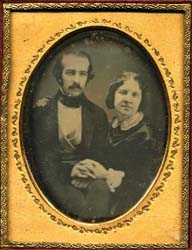
|
A broad theme we are interested in exploring at Mirror of Race is how whiteness was, and is, construed. In the America of the 19th century, and indeed well beyond that period, Jews belonged to a suspect category of people who might seem white but who did not fit the expectations of what made someone properly white. In the 19th century, nationality or ethnicity were often conflated with race, and so Jews faced exclusion not only on religious but also on racial grounds.
Jews were not alone in being subjected to this kind of scrutiny and exclusion from the full privileges that whiteness bestowed. The largely Protestant white population of the United States resisted accepting Irish Catholics as members of their kind, especially as large numbers of Irish began immigrating after the Potato Famine of the late 1840s. Later in the century, southern Europeans faced similar doubts and prejudice.
Otto Goldschmidt belonged to a class of persons who, as visitors to America, could rise above such prejudice, due to his being a highly educated foreigner (a German by birth) and to his success as a composer and performer of what the upper class in 19th century American society would have deemed one of the most refined cultural spheres: classical music. Furthermore, his marriage to Jenny Lind, one of the most beloved figures of the age, would have protected him to some extent, too.
We hope to present more images of Jews in mid-19th century America, especially ones who made their lives in the United States, for their story is necessarily different from that of a visitor and celebrity such as Goldschmidt. We welcome submissions for our essay publication page on the topic of Jewishness and race in the United States. |

